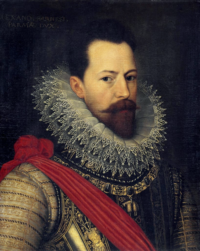Frederick Henry's Meuse campaign
| Meuse campaign | |||||||
|---|---|---|---|---|---|---|---|
| Part of the Eighty Years' War | |||||||
 The Siege of Maastricht was the most major siege during this campaign | |||||||
| |||||||
| Belligerents | |||||||
|
|
| ||||||
| Commanders and leaders | |||||||
|
|
| ||||||
| Strength | |||||||
|
Maastricht: 17000 infantry 4000 cavalry Roermond: 20000 men Venlo: Unknown |
Maastricht: 20000 infantry 6000 cavalry 3000 armed citizens Roermond: A garrison of 300 men Venlo: Unknown | ||||||
The Meuse campaign was a major operation during the Dutch Revolt lead by the Prince of Orange in which he took the cities of Venlo, Roermond, Sittard and Maastricht.[1][2][3]
Background[edit]
In 1572, 6 years after the revolt broke out, the Geuzen who backed the Prince of Orange, captured a lot of cities in the Netherlands. Including the cities which were key locations for this campaign. The aftermath of this being that the Union of Utrecht was proclaimed in 1579.

Shortly after, Philip II sent the Duke of Parma to the Netherlands as governor and reconquered large parts of the Netherlands previously occupied and captured by the Rebels, including the cities that were captured during the campaign, the most notable one being Parma's siege of Maastricht.[1]
Shortly after, in 1588. Maurice, Frederick's half-brother. Became the Prince of Orange and after his military reforms, conquered large parts of the territories previously captured by Parma, except for the cities that would be captured during this campaign.

In 1629, a few years before the initial campaign, Frederick Henry besieged and captured 's-Hertogenbosch, this would be known as his greatest achievement. The city of 's-Hertogenbosch was the last city that was in Spanish hands before Frederick could initiate his campaign. So the capture of 's-Hertogenbosch allowed Frederick Henry to launch his campaign.
Campaign[edit]
Siege of Venlo[edit]
The Siege of Venlo was the first major action of the campaign. This siege lasted from the 1st of June until the 4th of June when the garrison in Venlo was forced to capitulate.[4][5]
Siege of Roermond[edit]

The Siege of Roermond occurred on the 2nd of June until the 5th of June when a Dutch force of 20000 men took on a Spanish garrison of around 300 men and forced the garrison to capitulate. Even though the Dutch Army successfully took the city of Roermond, the Dutch still suffered a heavy loss due to the death of Ernest Casimir when he got shot when inspecting a nearby trench.[6]
Siege of Maastricht[edit]

The siege of Maastricht was the last and most major military action during the campaign. The siege itself lasted from the 9th of June until the 22nd of August, the siege was fought between the Dutch States Army lead by Frederick and Horace Vere and the combined forces of the Spanish and Imperial armies. After the outnumbered Dutch forces successfully besieged the city, the city was left in Dutch hands.[7]
Aftermath[edit]
Even though the campaign was a success for the Dutch, the cities of Roermond and Venlo would be recaptured by Spanish forces. Spanish forces would also try to recapture Maastricht, but without success.
Notes[edit]
- ^ Imperial troops participated in the Siege of Maastricht
- ^ Peter Bossman was the mayor of Roermond in 1632
References[edit]
- ^ a b Roberts 2020, p. 37-38.
- ^ Kollewijn 1878, p. 135.
- ^ Graddesz Hellinga, p. 86.
- ^ Wagenaar 1754, p. 151.
- ^ Die Haghe 1896, p. 62.
- ^ Krugten 1875, p. 27.
- ^ Parker 1990.
Sources[edit]
- Roberts, Andrew (2020). De grootste veldheren uit de vroegmoderne tijd, 1584-1865 (E-book ed.). VBK Media. ISBN 978-94-019-1730-8.
- A.M. Kollewijn (Nz) (1878). Leerboek der vaderlandsche geschiedenis, Volume 1 (E-Book ed.).
- Graddesz Hellinga, Gerben (2016). Geschiedenis van Oranje: de canon van ons Koninklijk Huis (E-book ed.). Amsterdam University Press. ISBN 978-94-6249-202-8.
- Wagenaar, Jan (1754). Vaderlandsche historie: vervattende de geschiedenissen der nu Vereenigde Nederlanden, inzonderheid die van Holland, van de vroegste tyden af: Uit de geloofwaardigste schryvers en egte gedenkstukken samengesteld. Met konstplaaten en kaarten opgehelderd, Volume 11 (E-book ed.).
- Vereeniging "Die Haghe" (1896). Catalogus van de tentoonstelling ter herinnering aan den 300jarigen geboortedag van Constantijn Huygen (E-book ed.). Van Stockum.
- Krugten, Hermanus (1875). Het mirakuleus beeld van Onze Lieve Vrouw in 't Zand te Roermond en de waardige Joanna van Randenraedt (E-book ed.). Romen.
- Parker, Geoffrey, The Dutch Revolt Penguin Books Ltd; 1990, ISBN 0-14-013712-2
- Conflicts in 1632
- 1632 in the Dutch Republic
- 1632 in the Habsburg Netherlands
- 17th-century military history of Spain
- Eighty Years' War (1621–1648)
- Sieges of the Eighty Years' War
- Battles involving the Dutch Republic
- Battles involving Spain
- History of Limburg (Netherlands)
- Battles involving the Holy Roman Empire
